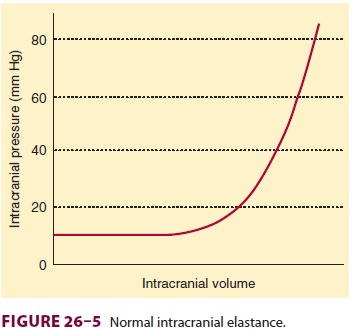Chapter: Clinical Anesthesiology: Anesthetic Management: Neurophysiology & Anesthesia
Intracranial Pressure

INTRACRANIAL PRESSURE
The
cranial vault is a rigid structure with a fixed total volume, consisting of
brain (80%)blood (12%), and CSF (8%). Any increase in one

component must be offset by an equivalent decrease in another to
prevent a rise in ICP. By convention, ICP means supratentorial CSF pressure
measured in the lateral ventricles or over the cerebral cortex and is normally
10 mm Hg or less. Minor varia-tions may occur, depending on the site measured,
but, in the lateral recumbent position, lumbar CSF pressure normally
approximates supratentorial pressure.
Intracranial elastance is determined by
mea-suring the change in ICP in response to a change in intracranial volume.
Normally, small increases in volume of one component are initially well
compen-sated (Figure26–5).
A point is eventually reached, however, at which further increases produce
precipi-tous rises in ICP. Major compensatory mechanisms include: (1) an
initial displacement of CSF from the cranial to the spinal compartment, (2) an
increase in CSF absorption, (3) a decrease in CSF production, and (4) a
decrease in total cerebral blood volume (primarily venous).
The concept of total intracranial
compliance is useful clinically, even though compliance probably varies in the
different compartments of the brain and is affected by arterial blood pressure
and Paco2. Cerebral blood volume is estimated to
increase 0.05 mL/100 g of brain per 1 mm Hg increase in Paco2. Blood pressure effects upon cerebral blood volume
are dependent on the autoregulation of CBF.

Sustained elevations in ICP can lead to
cata-strophic herniation of the brain. Herniation may occur at one of four
sites (Figure26–6):
(1) the cin-gulate gyrus under the falx cerebri, (2) the uncinate gyrus through
the tentorium cerebelli, (3) the cerebel-lar tonsils through the foramen
magnum, or (4) any area beneath a defect in the skull (transcalvarial).
Related Topics